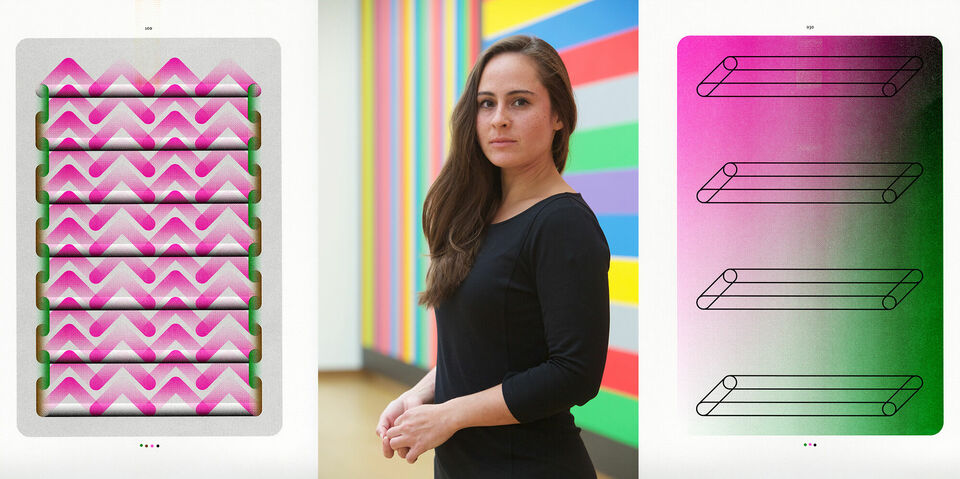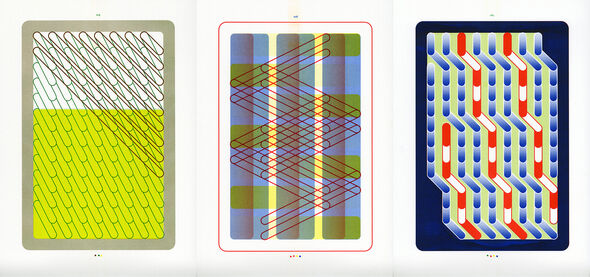New conservator for TU/e's art collection
In the course of her other work at the Stedelijk Museum Amsterdam, art historian Britte Sloothaak (1984) is surrounded by phenomenal international artworks. Nonetheless, she is equally enthusiastic about the art collection owned by TU/e, for which in her role as conservator she has been responsible since October 2020. “When I discover gems like the risograph prints by Sigrid Calon shown in the photos, I am thrilled.”
How interesting is a university's art collection when you are used to working among pieces by Mondriaan and Picasso? Very interesting, if you ask Britte Sloothaak. In October she succeeded Gerard Verhoogt as conservator of the TU/e art collection and member of the art committee. “The university's collection is a fine combination of works by local producers, nationally acclaimed artists and a handful of major talents of international stature, such as Panamarenko and Le Corbusier.”
In the Stedelijk Museum Sloothaak works as curator of temporary exhibitions. “Alongside this, I'm keen to develop as a conservator: the person who manages the permanent collection. My master's trained me as a museum conservator, but forms of collecting outside the museum context – such as at a university – also fascinate me.”
Techniques
Compiling an accurate inventory and categorizing all the works in the TU/e art collection is the first task that Sloothaak, together with an intern and a freelancer, set herself. “Can the title, the year and the origins of the piece be verified? Which materials and techniques have been used?”
“Once the basics have been sorted out, I'll start a collection value assessment. Using a system devised by the government, you divide the objects into categories based on their value in the collection. Based on this grading, you can then make policy and set priorities for things like digitalization and restoration.”
The TU/e collection consists not only of the sculptures on the campus and the paintings and drawings on the walls, but other items such as installations, wall paintings, tapestries, photographs, graphic art and digital videos. Some of the artworks can be taken out on loan by employees wishing to hang something striking in their office – not unfortunately in a home office! – or department.
Graphic patterns
Which artworks make Sloothaak's day when she sees them while taking the inventory? “If I had to name a personal favorite it would be the work of the Dutch artist Sigrid Calon. In its collection, TU/e has risograph prints by her with very cool graphic patterns, in beautiful colors. I also like the fact that this artist is a woman – true to form, men are often the top dogs in the art world.” When gems like these come along, she admits to being “thrilled”.
A feature of a living art collection is that it expands. Has Sloothaak already thought about new acquisitions? “That's something we decide as the art committee and we have to be meticulous in our choices because our budget is limited. What appeals to me is making sure with any purchase we make that we are contributing to the development of the local art scene, by discussing within the national or even international context what is happening in the art world in and around Eindhoven. The Design Academy is producing creative people with great potential. And I would like to work with organizations such as Onomotapee.”
Research
Alongside her work for the TU/e art committee and the Stedelijk, Sloothaak has now commenced her doctoral research within the chair of Architecture History and Theory. “The chair's field includes heritage.” Sloothaak is part of the Curational Research Collective, a research group led by Bernard Colenbrander and Sergio M. Figueiredo. She is currently writing her research proposal. “I am looking at the museum's view of the Dutch East Indies and later Indonesia, as evidenced by, say, exhibitions. The museum now has a part to play in creating a decolonial perspective, but this starts with realizing and acknowledging the museum's own historical role in colonial thought.”



Discussion